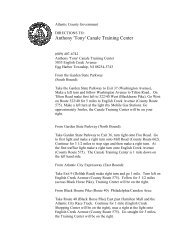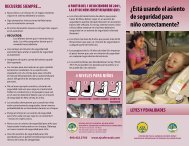Asbestos fact sheet - Atlantic County
Asbestos fact sheet - Atlantic County
Asbestos fact sheet - Atlantic County
You also want an ePaper? Increase the reach of your titles
YUMPU automatically turns print PDFs into web optimized ePapers that Google loves.
<strong>Atlantic</strong> <strong>County</strong> Division of Public Health<br />
Questions and Answers about <strong>Asbestos</strong><br />
What is asbestos?<br />
<strong>Asbestos</strong> is the name applied to a family of strong, flexible fibrous minerals. It does not easily burn or<br />
react with other chemicals. <strong>Asbestos</strong> has no odor or taste. There are several different types of asbestos:<br />
chrysotile (white), the most common; crocidolite (blue); amosite (brown); and anthrophillite (gray).<br />
How is asbestos used?<br />
<strong>Asbestos</strong> has been used in insulation wrapped around hot water pipes and boilers, fireproof materials, roof<br />
materials, car brakes, clutches and transmissions, paper products, textiles, cement pipes and reinforced<br />
plastics.<br />
Could I be exposed to asbestos?<br />
Air - in the city or the country - contains small amounts of asbestos in levels that do not appear to cause<br />
any harm. <strong>Asbestos</strong> fibers get into the air when products containing asbestos - for example, roof shingles,<br />
insulation, floor and ceiling tiles and brakes and clutches - wear out.<br />
Could I be exposed to a large amount of asbestos?<br />
People who work with asbestos day after day without proper protection - for example, miners, automobile<br />
brake mechanics and insulation workers - are likely to be exposed to much higher concentrations of<br />
asbestos in the air than other people.<br />
Can asbestos get inside my body? Does it stay there?<br />
When you breathe in asbestos fibers, some of them land on the cells that make up your lungs and airways.<br />
Most of the fibers end up in mucous that coats the lungs and are brought up or coughed up into the throat<br />
and swallowed, within a few hours. Most swallowed asbestos fibers leave the body through the feces<br />
within a few days. Some fibers stick inside the lung cells and lodge even deeper, where they may stay for<br />
a lifetime. Very few fibers get into the body through the skin, even if you come into contact with asbestos.<br />
What are the health effects if I am exposed to asbestos?<br />
There are no known immediate effects at the time of exposure. <strong>Asbestos</strong> does not cause allergies,<br />
headache, burning eyes, sore throat or skin problems. In general, asbestos-related lung disease results only<br />
from intense asbestos exposure experienced over a period of many years, primarily as a consequence of<br />
occupational exposures. The risk of developing an asbestos-related illness following an exposure of short<br />
duration, even to high levels, is very low.<br />
When asbestos causes health problems, it is many years - perhaps 20 to 40 - after you are exposed. People<br />
who were exposed to high levels of asbestos in the workplace over a long period of time have an<br />
increased chance of getting certain diseases, including lung cancer, digestive tract cancer, mesothelioma<br />
(a cancer that starts in tissues lining the lung or abdominal cavity) and asbestosis (a scarring disease of the<br />
lungs).<br />
How much asbestos does it take to cause those diseases?<br />
Whether or not asbestos exposure will cause disease depends upon how long a person is exposed to<br />
asbestos, how long it has been since the person's exposure began and whether the person smokes<br />
cigarettes.<br />
201 South Shore Road Northfield, NJ 08225 Phone: 609-645-5935 www.aclink.org/publichealth
<strong>Atlantic</strong> <strong>County</strong> Division of Public Health<br />
Questions and Answers about <strong>Asbestos</strong><br />
Can a medical test show whether I have been exposed to asbestos?<br />
No. A chest X-ray can show early signs of lung disease, but will not show asbestos fibers. Testing can<br />
identify the presence of asbestos fibers in phlegm and other fluids from the lung and in urine and feces.<br />
But since nearly everyone breathes in a little asbestos, nearly everyone has a few fibers in their body<br />
fluids and body wastes. These tests cannot tell how serious your asbestos exposure is or whether you are<br />
likely to suffer health effects.<br />
Could a one -time incident that exposes me to asbestos - such as a burst steam pipe - affect my<br />
health?<br />
The amount of asbestos released in a one-time incident is not likely to affect your health. It will most<br />
likely not expose you to much more asbestos, over the long run, than you would be exposed to from the<br />
air we all breathe. Still, if you are involved in an asbestos incident, it makes sense to reduce your<br />
exposure to asbestos. If asbestos has been released near where you live, turn off all air conditioners, shut<br />
off ventilation systems that use outside air and close the windows. You might be also asked to either go to<br />
a decontamination trailer that is sometimes brought to asbestos-release sites, so that asbestos can be<br />
removed from your body and clothing, or to simply take a shower.<br />
Can tests show if there is asbestos in materials, in the air and on surfaces?<br />
Yes. Trained responders inspect the area and sample the materials to be tested for asbestos, take air<br />
samples to determine the concentration of asbestos fibers and take "wipe" samples by pressing an<br />
adhesive tape against surfaces and then testing the tape to find out how much asbestos is stuck onto it.<br />
Do these tests show how much asbestos is in the environment and whether there should be a special<br />
asbestos clean-up?<br />
No. Even if there is a lot of asbestos in the material, there may not be much in the environment. "Wipe"<br />
samples can only detect the presence of asbestos and wipe sample results cannot determine amounts of<br />
asbestos inhaled or the health risk. The concentration of asbestos in the air is the only measure that can<br />
help estimate people's exposure to asbestos.<br />
How do I get asbestos off of me and my things after it has gotten on them?<br />
To clean asbestos from: Do this:<br />
People Take a shower at home or in a decontamination trailer.<br />
Clothes Rinse with running water from a hose or faucet prior to<br />
cleaning in a washing machine.<br />
Pets Clean with running water from a hose or faucet.<br />
Foods Throw away any food that may have been contaminated<br />
with asbestos, except for food in cans, jars or containers<br />
with tight-fitting lids. Just wash the can or jar with water<br />
and wipe it clean. If in doubt, throw it out.<br />
Plants Rinse leaves with water and replace the potting soil.<br />
Rugs and carpets HEPA* vacuuming.<br />
Furniture HEPA* vacuuming.<br />
Air conditioners HEPA* vacuuming.<br />
Cars, vehicles, bicycles HEPA* vacuuming.<br />
*HEPA stands for High Efficiency Particulate Air filter, used in a type of vacuuming that removes very tiny particles.<br />
201 South Shore Road Northfield, NJ 08225 Phone: 609-645-5935 www.aclink.org/publichealth
<strong>Atlantic</strong> <strong>County</strong> Division of Public Health<br />
Questions and Answers about <strong>Asbestos</strong><br />
How dangerous is asbestos exposure compared to other health risks?<br />
Minimal exposure to asbestos is not very dangerous - unless you are both exposed to asbestos on the job<br />
and you smoke. If you have both risks, the risk that you will get one of the diseases is much higher than<br />
you would expect from simply adding up the asbestos risk and the smoking risk.<br />
For people without both risks, there is very little danger. A Harvard University study found that out of<br />
every 100,000 premature deaths, smoking is responsible for 21,900 deaths; car accidents cause 1,600;<br />
medical X-rays, 75; lightning, 3; and exposure to asbestos in buildings, only an estimated one death. And<br />
a 1990 article in Science, a respected "peer-reviewed" professional journal, stated, "Chrysotile asbestos,<br />
the type of fiber found predominantly in U.S. schools and buildings, is not a health risk in the nonoccupational<br />
environmental environment." The American Medical Association concluded in 1991 that<br />
asbestos in buildings is far less of a health risk to the people living in them than smoking, drug and<br />
alcohol abuse, poor diet and too little exercise.<br />
How do I protect myself against asbestos disease?<br />
The best protection is to make sure you breathe as few asbestos fibers as possible. If you think there may<br />
be asbestos in material where you live - for example, in the boiler room, on hot water pipes or behind the<br />
radiator - and it is in one piece and not crumbling - it is best to leave it alone. Trying to remove it will<br />
only release asbestos fibers into the air. If the material is already broken up, first spray water on it to<br />
dampen it, then clean it up from the floor, window sill or table.<br />
In an emergency, call the Poison Control Center at 1-800-222-1222.<br />
Information compiled from the New York Department of Health and Mental Hygiene<br />
201 South Shore Road Northfield, NJ 08225 Phone: 609-645-5935 www.aclink.org/publichealth







